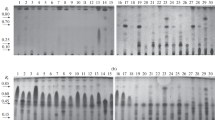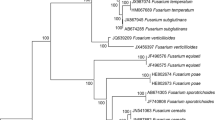Abstract
296 isolates of Fusarium spp. from 100 samples of cereale grains were examined for their ability to produce zearalenone on liquid culture medium. Thin layer Chromatographic analysis revealed that the mycotoxin was detected from 45 isolates, (F. oxysporum, 36; F. moniliforme, 8; and F. equiseti, one isolate). A suitable liquid medium and some optimal conditions for the biosynthesis of zearalenone were reported. Glutamine and riboflavin stimulated the production of the toxin. The maximum amount of zearalenone appeared at pH 7, after 12 days of incubation at 20 °C.
Similar content being viewed by others
References
Bacon, C.W., Robbins, J.D. & Burdick, D., 1975. Metabolism of glutamic acid in Aspergillus ochraceus during the biosynthesis of ochratoxin A. Appl. Microbiol. 29: 317–322.
Bacon, C. W., Robbins, J. D. & Porter, J. K., 1977. Media for identification of Gibberella zeae and production of F-2(zearalenone). Appl. Environ. Microbiol. 33: 445–449.
Caldwell, R. W., Tuite, J., Stob, M. & Baldwin, R., 1970. Zearalenone production by Fusarium species. Appl. Microbiol. 20: 31–34.
Capellini, R.A. & Peterson, J.L., 1965. Macroconidium formation in submerged culture by a nonsporulating strain of Gibberella zeae. Mycologia 57: 962–966.
El-Maraghy, S.S., 1980. Studies on toxins production by Fusarium species. M.Sc. Thesis, Botany Department, Faculty of Science, Assiut University, Egypt.
Ferreira, N.P., 1968. The effect of amino acids on the production of ochratoxin A in chemically defined media. Antonie van Leeuwenhoek J. Microbiol. Serol. 34: 433–440.
Ishii, K., Sawano, M., Ueno, Y. & Tsunoda, H., 1974. Distribution of zearalenone-producing Fusarium species in Japan. Appl. Microbiol. 27: 625–628.
Jackson, R. A., Fenton, S. W., Mirocha, C. J. & Davis, G., 1974. Characterization of two isomers of 8′-hydroxyzearalenone and other derivatives of zearalenone. J. Agric. Food Chem. 22: 1015–1019.
Mirocha, C. J., Harrison, J., Nichols, A. A. & McClintoc, M., 1968. Detection of fungal estrogen (F2) in hay associated with infertility in dairy cattle. Appl. Microbiol. 16: 797–798.
Mirocha, C.J., Christensen, C. M. & Nelson, G. H., 1971. F-2(zearalenone) estrogenic mycotoxin from Fusarium. In: S. Kadis, A. Ciegler & S. J. Ajl (eds.), Microbial toxins, vol. 7. Academic Press Inc., New York. pp. 107–138.
Palti, J., 1978. Toxigenic Fusaria, their distribution and significance as cause of disease in animal and man. Verlag Paul Parey (Publ.) Berlin und Hamburg, pp. 49.
Walpole, 1914. In: A. J. Vogel. A text book of quantitative analysis. Second ed. 1953. Longmans Green and Coy. (London-New York-Toronto).
Author information
Authors and Affiliations
Rights and permissions
About this article
Cite this article
El-Kady, I.A., El-Maraghy, S.S. Screening of zearalenone-producing Fusarium species in Egypt and chemically defined medium for production of the toxin. Mycopathologia 78, 25–29 (1982). https://doi.org/10.1007/BF00436578
Issue Date:
DOI: https://doi.org/10.1007/BF00436578




